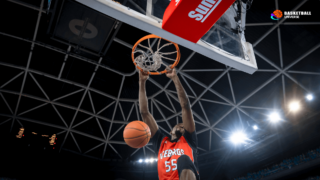
No-Timeout Rule in Basketball
Written by: Basketball Universe
Last updated:

Imagine a nail-biter of a game where the seconds are ticking down, the score is neck and neck, and suddenly… there’s no pause, no break for strategy, just the unyielding exhilaration of continuous play. Welcome to the world of the No-Timeout Rule in Basketball! In this blog post, we’ll dive deep into the thrilling arena of this lesser-explored aspect of the sport that will have you on the edge of your seat. From its underpinnings in various formats to key gameplay implications, we’ll break it all down, making sure you become a true savant of this pulse-pounding rule. So lace up your sneakers, grab some popcorn, and let’s get ready to embrace the unstoppable momentum that is the No-Timeout Rule in Basketball!
No-Timeout Rule in Basketball
The No-Timeout Rule in basketball refers to a game format where teams are not allowed to call timeouts, thus creating a continuous, fast-paced playing environment. This rule can be implemented in various amateur and professional contexts to emphasize quick thinking, effective decision-making, and uninterrupted action. Without timeouts, players and coaches must rely heavily on pre-established strategies and adapt to changing game situations on-the-fly, adding an extra layer of excitement and challenge to the sport.
Embracing the Fast-Paced Nature of Basketball
Considered an essential part of the game, timeouts give teams a chance to regroup and refine their strategies during the ebbs and flows of a match. However, the No-Timeout Rule in Basketball shakes things up, fostering a more unfettered and electrifying atmosphere on the court. The urgency imposed by the absence of timeouts pushes players to their limits and coaches to innovate, making for fascinating matches with relentless action. In this article, we’ll explore various facets of this rule and how it impacts the basketball landscape.
The Origins and Evolution of the No-Timeout Concept
It’s vital to understand the origin of the No-Timeout rule and the various iterations that have surfaced across different leagues and formats. While many purists might think of this rule as blasphemy, it didn’t just pop up overnight. Instead, it’s a byproduct of decades of experimentation and adaptation that aims to enhance the game’s dynamism.
Amateur and Recreational Leagues
The No-Timeout Rule traces its origins to amateur and recreational leagues, where the primary goal is to encourage player engagement while reducing game delay. These leagues often have shorter game durations and limited referee involvement, allowing for a more relaxed and beginner-friendly environment. By eliminating timeouts, the focus shifts to fostering camaraderie, sportsmanship, and a heightened sense of fun.
Professional Leagues
In professional basketball, No-Timeout games are quite uncommon. However, certain leagues and exhibition matches have embraced this format to experiment and keep fans entertained. For example, the BIG3 league – a professional 3-on-3 basketball league – features a No-Timeout rule as part of their innovative game design to create an exhilarating spectator experience by ensuring continuous gameplay.
How the No-Timeout Rule Affects Various Elements of the Game
The No-Timeout rule goes beyond merely keeping the clock running – it sets the stage for a unique experience that affects a multitude of game elements. The impact of continuous play without timeouts spans various aspects of the sport, leading to exciting enhancements and new challenges for both players and coaches.
Player Stamina and Fatigue
While the fast-paced nature of basketball already demands a high level of physical fitness, the absence of timeouts takes it one step further. Without the opportunity to pause and rest, players must develop exceptional stamina to endure the game’s unyielding pace. This rule not only heightens the need for peak conditioning but also brings to light the importance of the players’ mental resilience in managing fatigue and pushing through exhaustion.
On-the-Fly Decision-Making and Adaptation
In traditional basketball games, timeouts provide an essential window for teams to evaluate the ongoing match and adjust their game plan accordingly. However, the No-Timeout rule forces players and coaches to adapt their strategies on the fly, honing their decision-making and problem-solving abilities. Without these breaks, teams must communicate seamlessly, refine their tactics in real-time, and exhibit greater mental acuity in the heat of the moment.
Implications for Coaches: Emphasizing Tactics and Preparation
For basketball coaches, the No-Timeout rule is a fascinating challenge that tests their understanding of the game and ability to prepare their teams effectively. The absence of timeouts to make in-game adjustments shifts the responsibility toward thorough pre-game analysis and comprehensive game plans, so that players can rely on these established strategies within the fast-paced environment.
No-Timeout Basketball Rules: Developing Quick-Witted Players
The no-timeout rule in basketball is physically and mentally demanding, but it contributes to nurturing quick-witted and strategic players who can endure the fast pace. And, for coaches, the rule encourages emphasis on preparation and deep tactical acumen. No-Timeout games are a fantastic platform for players to develop valuable skills and qualities that translate well into traditional basketball formats.
Increased Situational Awareness
No-Timeout basketball promotes situational awareness, as players must continuously scan the court and assess changing game scenarios in real-time. Players develop an acute sense of focus, grasp the ebb and flow of the game, and better understand their opponents’ tactics without the luxury of timeouts to analyze these essential elements.
Enhanced Communication
Efficient communication is indispensable in any team sport, and No-Timeout basketball exemplifies this even more. Players must rely on a seamless exchange of verbal and non-verbal cues to implement strategies, adapt to in-game situations, and operate fluidly as a unit on the court. The skills honed in No-Timeout games enhance players’ abilities to communicate effectively in high-pressure situations.
Building Mental Toughness
Playing under the No-Timeout rule nurtures mental toughness, enhancing players’ ability to cope with the demanding nature of the sport. Players are pushed out of their comfort zones, forced to handle fatigue, and maintain focus and confidence throughout the game. This rule is an excellent way to build players’ resilience and ability to manage stress during tight games.
Adapting Your Game to No-Timeout Basketball
Whether you’re a player, coach, or a fan ready to try No-Timeout basketball in your next pick-up game, it’s crucial to adapt your gameplan to reflect the format’s unique demands. Approaching a No-Timeout game with a traditional outlook will put your team at a significant disadvantage. Here are some tips and strategies to consider for optimizing gameplay under the No-Timeout rule.
Efficient Substitutions
Under the No-Timeout rule, it’s crucial to manage player rotations with precision. Teams must employ smartly planned substitutions to maintain peak performance on the court while providing adequate rest for players. Coaches need to think critically about the balance between rotation flexibility and maintaining continuity among the players on the court.
Streamlined Playbook
With limited opportunities to make in-game adjustments, coaches must create a streamlined playbook for No-Timeout games. Key plays should be simple, versatile, and easy to implement amidst the chaos of continuous play. Teams should focus on mastering a few well-defined schemes rather than overloading with intricate and situational strategies.
Building Players’ Decision-Making Aptitude
Coaches must work to develop the decision-making aptitude of their players to thrive under the No-Timeout rule. Through targeted training drills and situational practice, players can learn to read the game quickly, adjust their gameplay, and collaborate as a unified team.-
Exploring Unique Game Formats Using the No-Timeout Rule
While No-Timeout basketball might not be the go-to format for traditionalists, it has spawned innovate game adaptations that take full advantage of its infectious energy. These game formats and variations can serve as entertaining alternatives for players and fans who crave a different take on the game they love.
3-on-3 Basketball
Inspired in part by street basketball, 3-on-3 basketball has grown in popularity and now frequently incorporates the No-Timeout rule. With fewer players on the court, 3-on-3 basketball already has an accelerated pacing. The absence of timeouts complements this format, further enhancing its pick-up-and-play appeal.
Exhibition Games and Fundraisers
Exhibition games and charity fundraisers often use unconventional rules and formats to entertain and engage fans. The No-Timeout rule can be an excellent addition to these types of events, as it generates vibrant energy and lively gameplay that hold the audience captive and create memorable moments.
Welcoming the No-Timeout Rule in Basketball with Open Arms
Whether you’re a seasoned avid player or a basketball enthusiast, the No-Timeout rule offers a refreshing twist that’s both exhilarating and challenging. By understanding how this rule impacts the dynamics of the game and becoming familiar with strategies to adapt, you can make the most of your no-timeout basketball adventure. Give it a shot, and you might just fall in love with this intriguing innovation that injects an exciting dimension into the beautiful sport of basketball.
Spectator Appeal of No-Timeout Basketball
In addition to impacting the players and coaches involved, the No-Timeout rule holds an undeniable appeal for spectators watching the game. The quick pacing and relentless action create a thrilling atmosphere that keeps the audience engaged and eager to see what happens next. In this section, we’ll discuss how the No-Timeout rule benefits the fan experience and offers unparalleled entertainment value.
Uninterrupted Flow and Viewing Experience
One of the primary advantages of No-Timeout games for fans is the seamless flow of the game. Without interruptions from timeouts, the action becomes more fluid and consistent, heightening the viewing experience. No-Timeout games are less likely to result in lulls or dull moments, creating an engaging match from tip-off to the final buzzer.
Highlight Worthy Plays
No-Timeout basketball is conducive to stunning and highlight-worthy plays that fans love. As players adapt to the format, they’re likely to produce remarkable moments of athleticism, skill, and strategic thinking that energize the crowd. In this fast-paced environment, it’s not uncommon to see buzzer-beaters, last-second heroics, and game-changing sequences that fans can’t resist talking about long after the game ends.
The Underdog Factor
The No-Timeout rule can level the playing field in certain situations, giving underdogs a chance to surprise and defeat more dominant opponents. By throwing conventional strategies out the window and forcing a fluid play style, No-Timeout games create a volatile, unpredictable environment where upsets are more likely. These unexpected results are always thrilling for basketball fans, generating excitement and debate in equal measure.
Maximizing Benefits of No-Timeout Basketball
While the No-Timeout rule might not suit every player, team, or league, its unique pacing and challenging nature can be highly beneficial under the right circumstances. As a player or coach, learning to leverage the specific characteristics of No-Timeout basketball can help you broaden your skillset and appreciate different perspectives on the game. Here are some tips to maximize the opportunities provided by the No-Timeout rule.
Developing a Fast-Break Offense
No-Timeout games favor teams that can move quickly and score efficiently in transition. Rapid and aggressive fast-break offense becomes even more critical in this format, so refining your running game can give your team an edge in No-Timeout matches. Regularly practice fast-break drills and ensure your players have strong conditioning to support this gameplay approach.
Reinforcing Defensive Intensity
Defense plays a significant role in No-Timeout basketball as players must respond to relentless offensive pressure. To hone a robust defensive strategy, concentrate on communication, timely rotations, and the ability to create turnovers. Make sure your players can effectively manage their defensive energy and maintain focus throughout the game.
Embracing and Learning from Adversity
No-Timeout games test your resilience and demand flexibility in response to changing game situations. By embracing the adversity created by this rule, both players and coaches can learn valuable lessons and build critical skills that translate to all forms of basketball. Nurture a growth mindset and use experiences from No-Timeout games to improve your overall gameplay, coaching, and teamwork abilities.
With the No-Timeout rule offering a unique and exciting alternative to traditional basketball, players, coaches, and fans can gain a fresh perspective on the sport they love. By understanding the origins, implications, and advantages of this rule, and learning to adapt and capitalize on its characteristics, anyone involved in basketball can enjoy a new layer of excitement and challenge that the No-Timeout rule delivers.
Frequently Asked Questions
In this FAQ section, we provide answers to some common questions related to the No-Timeout rule in basketball. With a deeper understanding of this unique format, you can better appreciate the nuances of the game and the factors that make No-Timeout basketball an exciting alternative to traditional gameplay.
Why does the No-Timeout rule exist in basketball?
The No-Timeout rule exists to create an alternative basketball format that emphasizes continuous, fast-paced play. It encourages players to rely on quick thinking and adaptability, while increasing spectator appeal through uninterrupted action and heightened competition.
Is it possible for a game to have a hybrid timeout structure?
Yes, it’s possible to design a hybrid timeout format that combines elements of traditional basketball games with No-Timeout rules, such as limiting the number of timeouts or modifying the duration. This approach can still encourage a fast-paced gamе while retaining some elements of strategy found in traditional formats.
Do any professional leagues use the No-Timeout rule in their games?
Although No-Timeout games are uncommon in professional leagues, some leagues and exhibition matches implement this format to experiment and entertain fans. The BIG3 league, a professional 3-on-3 basketball league, is one example that incorporates the No-Timeout rule into their game design.
How do coaches adapt their strategies to suit the No-Timeout rule?
Coaches must focus on thorough pre-game analysis, create streamlined playbooks, and employ efficient substitutions to balance performance and rest. Emphasizing decision-making aptitude, improved communication among players, and fostering mental toughness can also help teams adapt to this rule.
What are the ideal skill sets for players participating in No-Timeout games?
Players in No-Timeout games should possess exceptional physical conditioning, mental resilience, situational awareness, and the ability to make quick decisions. Adaptive communication and problem-solving skills are also essential for success in No-Timeout matches.
Is the clock stopped during dead-ball situations in No-Timeout games?
Yes, the clock may be stopped during dead-ball situations such as fouls, out-of-bounds plays or end-of-period scenarios, just like in traditional basketball games. However, the absence of timeouts means that these are the only instances when play is paused in No-Timeout games.
How can a player prepare for the unique demands of No-Timeout basketball?
Players can prepare for No-Timeout basketball by honing their conditioning, mental resilience, and game awareness. Participating in high-intensity training drills, improving communication, and learning to read the game quickly can also help ensure success in this fast-paced format.
Can No-Timeout rules be applied to different formats of basketball, like street and 3-on-3 games?
Yes, No-Timeout rules can be applied to various formats, including street basketball and 3-on-3 games. The rule can complement these formats, further enhancing their fast-paced nature and spontaneous gameplay, making them more appealing and engaging to players and fans alike.
How do spectators benefit from the No-Timeout rule?
Spectators are treated to an uninterrupted, fluid viewing experience in No-Timeout games. They enjoy fast-paced gameplay, thrilling highlight-worthy plays, and increased unpredictability, which can make the games more entertaining and appealing.
Can a system of limited timeouts be used as a middle ground between traditional and No-Timeout games?
Yes, adopting a limited timeout system can create a middle ground between traditional and No-Timeout games. This approach retains some strategic elements while still emphasizing a faster pace and fostering adaptable gameplay, providing a unique combination of both formats.
Featured Posts
- No pillar pages found.





